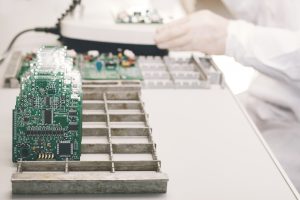 In many applications, air cooling is the most efficient thermal management solution, and modern heat exchangers can provide it with maximum efficiency and minimal energy usage. Yet, for many advanced, high-performance technological applications, air cooling and the units that achieve it are often not viable. For instance, today’s smart devices and small but powerful processors require solutions that can be customized to fit any space without losing any efficiency. To achieve this, many of them require liquid cooling solutions that can transfer high levels of heat consistently while fitting comfortably into minimal design spaces. Therefore, cold plate heat exchangers are often the optimal solution, providing liquid cooling within a closed-loop system that can fit into virtually any application.
In many applications, air cooling is the most efficient thermal management solution, and modern heat exchangers can provide it with maximum efficiency and minimal energy usage. Yet, for many advanced, high-performance technological applications, air cooling and the units that achieve it are often not viable. For instance, today’s smart devices and small but powerful processors require solutions that can be customized to fit any space without losing any efficiency. To achieve this, many of them require liquid cooling solutions that can transfer high levels of heat consistently while fitting comfortably into minimal design spaces. Therefore, cold plate heat exchangers are often the optimal solution, providing liquid cooling within a closed-loop system that can fit into virtually any application.
The Benefits of Liquid Cooling
Liquid cooling is the process of circulating cooling fluid across designated areas to collect and transfer excess waste heat in a continuous cycle. Compared to other methods, liquid cooling is a more agile solution. The cold plates can be crafted to any size and the flow paths machined into them can direct the cooling fluid as needed. By combining plates, heat exchangers can accomplish higher levels of heat transfer without needing much extra space. Cold plate units are also typically quieter than many air coolers, which is especially beneficial for personal computers and consumer electronics.
How Cold Plates Operate
The secret to how cold plates work lies in their unique designs and combination of eco-friendly heat transfer methods. Excess heat is collected on one side of the plate, and then absorbed by the cooling fluid that flows through it. The fluid is transferred to a small heat sink or other cooling area away from sensitive electrical components, where it can be safely released.
To learn more about looped liquid cooling with cold plate heat exchangers, call Noren Thermal, Inc. in Taylor, TX, at 866-936-6736.







